
How to Use 3S 12.6V 2A 18650 Lithium Battery Charger Module Type C: Examples, Pinouts, and Specs
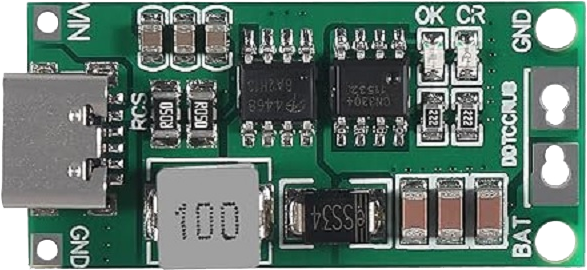
 Design with 3S 12.6V 2A 18650 Lithium Battery Charger Module Type C in Cirkit Designer
Design with 3S 12.6V 2A 18650 Lithium Battery Charger Module Type C in Cirkit DesignerIntroduction
The 3S 12.6V 2A 18650 Lithium Battery Charger Module is a compact and efficient charging solution designed for charging three 18650 lithium-ion batteries connected in series. It provides a maximum output voltage of 12.6V and a charging current of up to 2A. The module features a Type C USB interface, making it compatible with modern power sources such as USB-C adapters, power banks, and laptops.
Explore Projects Built with 3S 12.6V 2A 18650 Lithium Battery Charger Module Type C
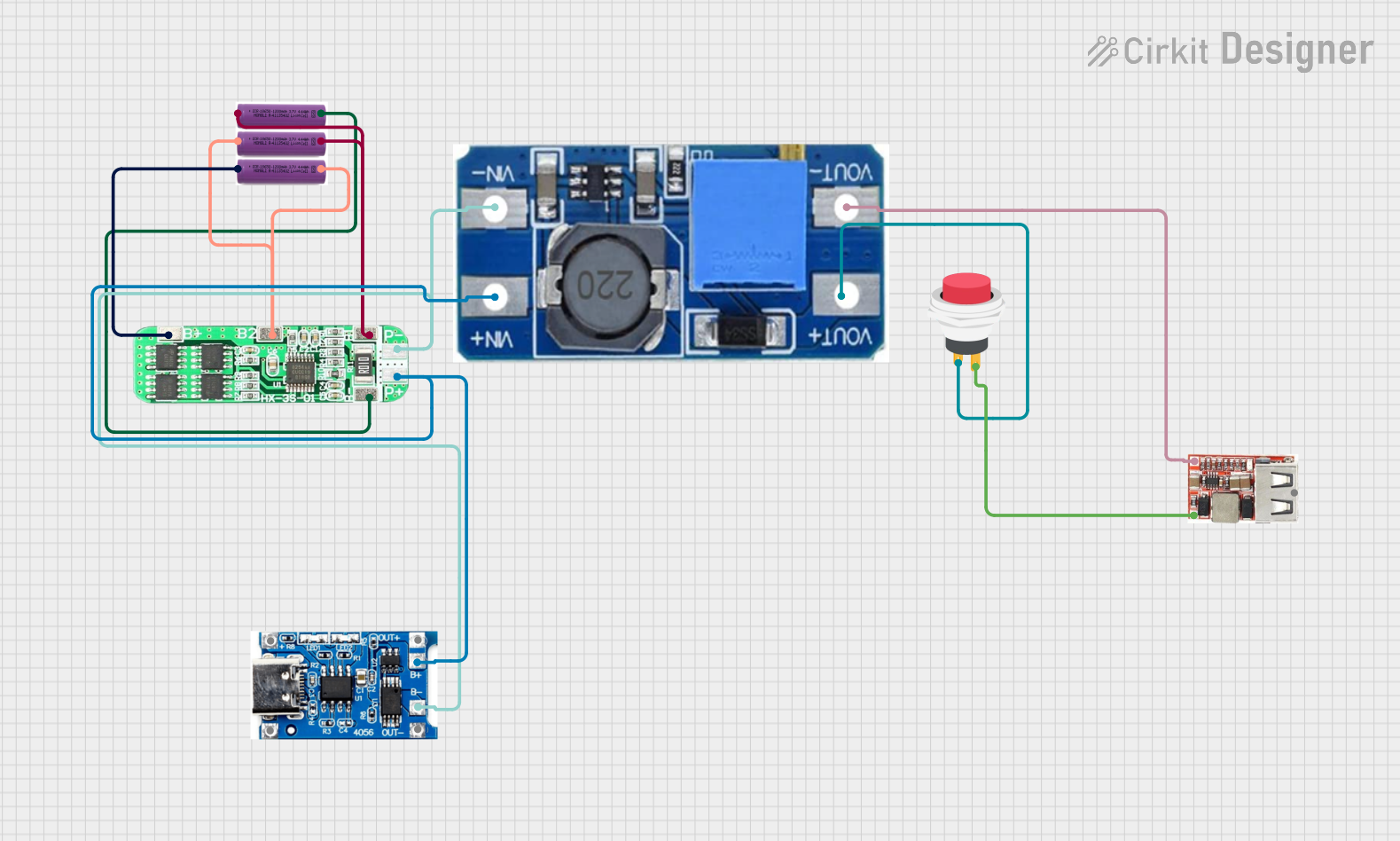
 Open Project in Cirkit Designer
Open Project in Cirkit Designer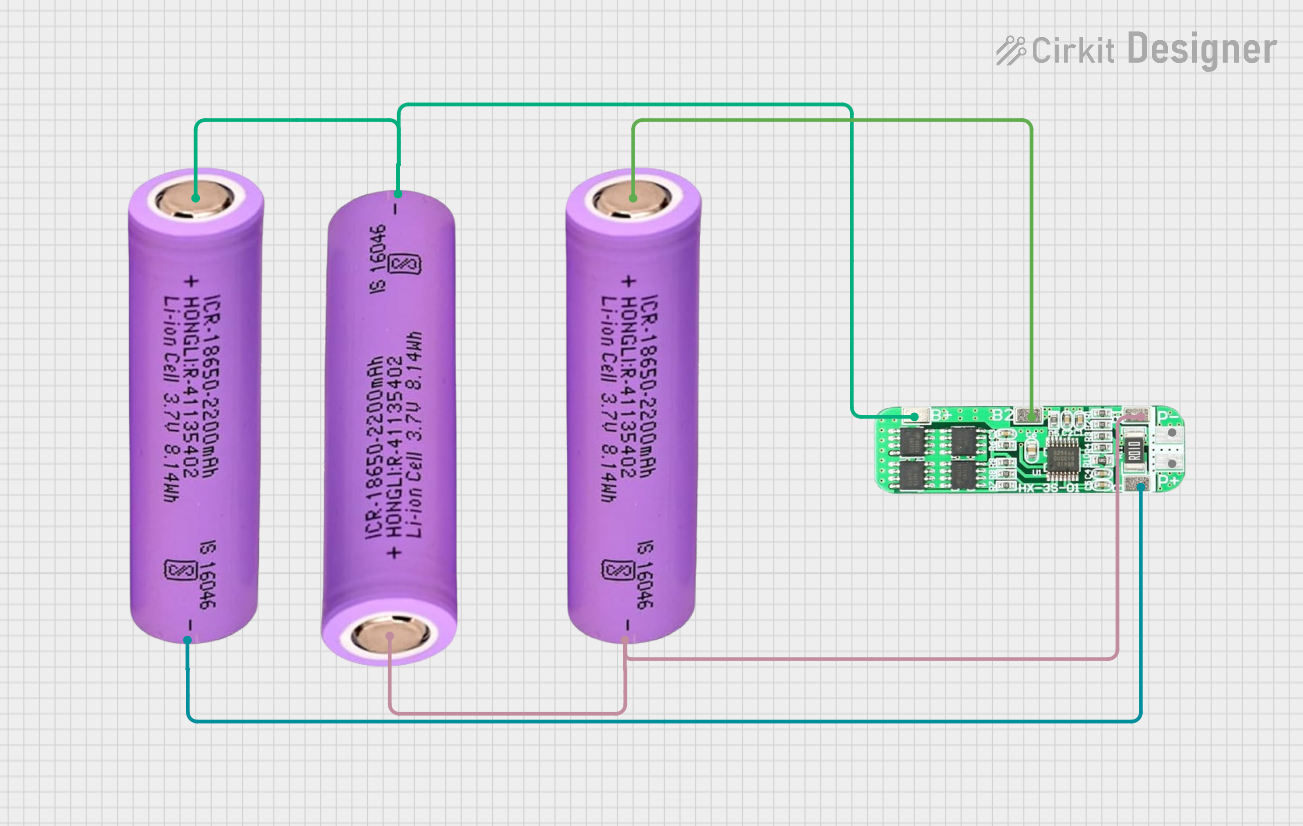
 Open Project in Cirkit Designer
Open Project in Cirkit Designer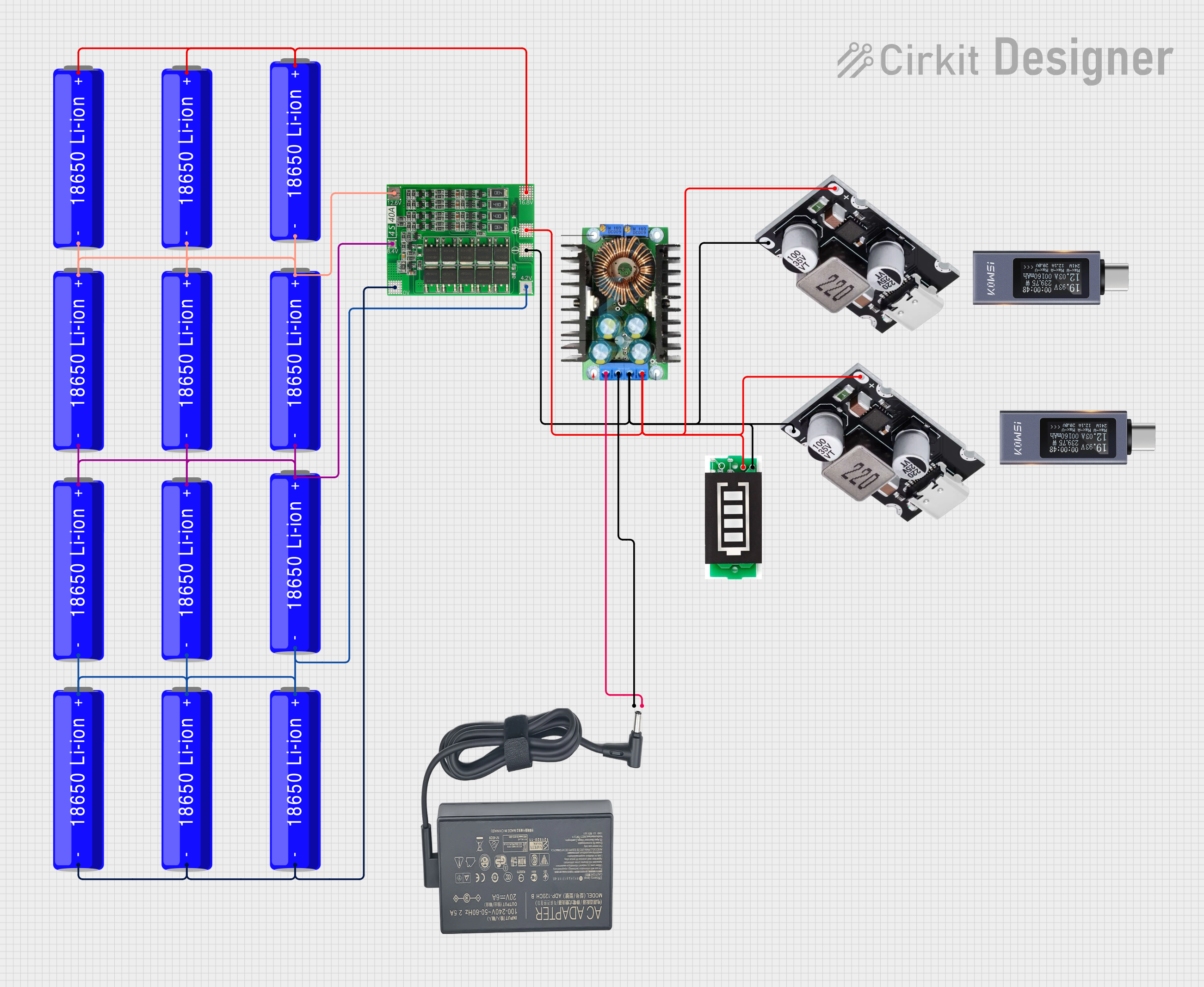
 Open Project in Cirkit Designer
Open Project in Cirkit Designer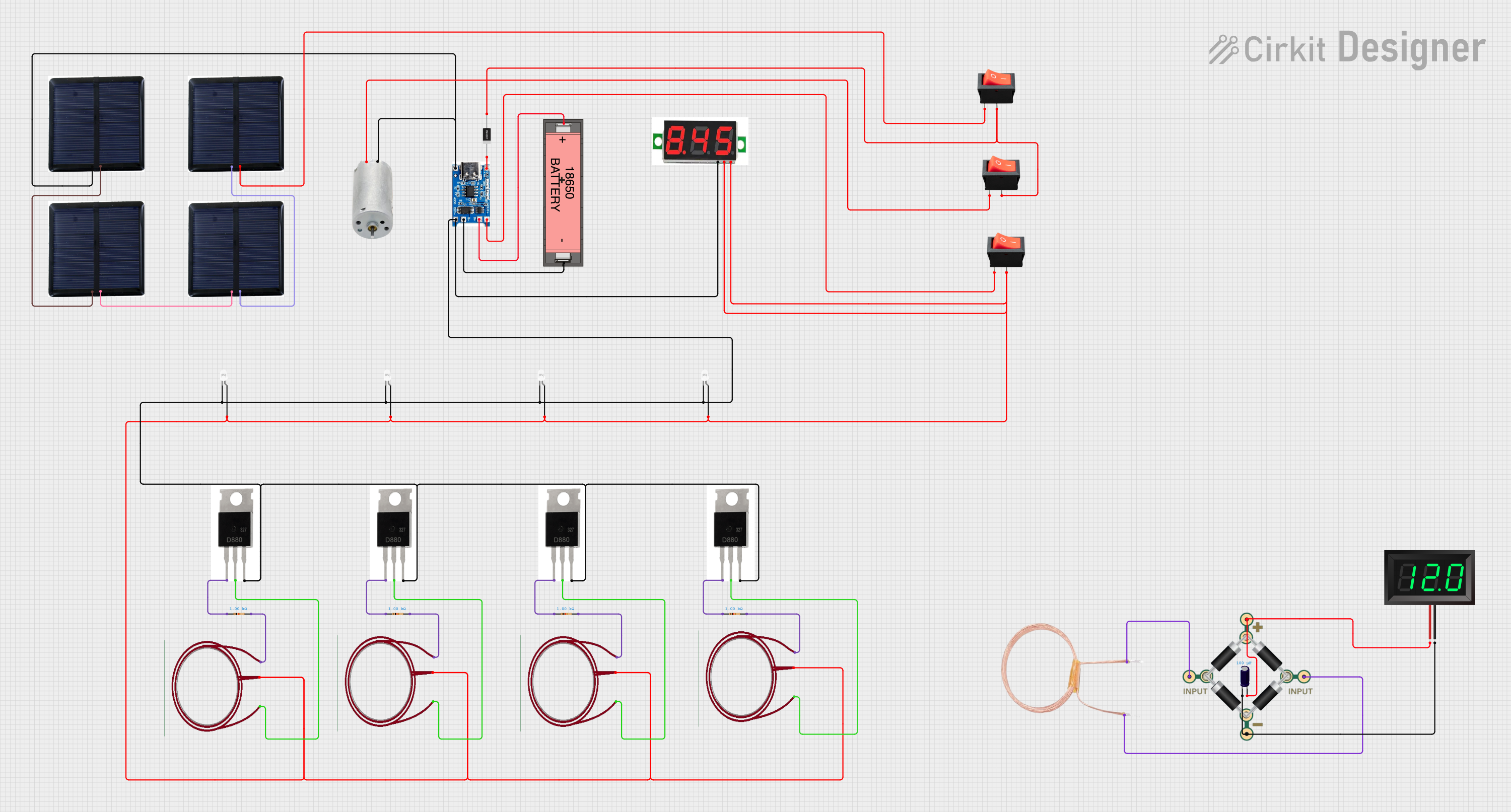
 Open Project in Cirkit Designer
Open Project in Cirkit DesignerExplore Projects Built with 3S 12.6V 2A 18650 Lithium Battery Charger Module Type C

 Open Project in Cirkit Designer
Open Project in Cirkit Designer
 Open Project in Cirkit Designer
Open Project in Cirkit Designer
 Open Project in Cirkit Designer
Open Project in Cirkit Designer
 Open Project in Cirkit Designer
Open Project in Cirkit DesignerCommon Applications and Use Cases
- Powering portable electronic devices
- DIY battery packs for robotics and IoT projects
- Backup power systems
- Battery maintenance and charging for 3S lithium-ion configurations
Technical Specifications
Below are the key technical details of the 3S 12.6V 2A 18650 Lithium Battery Charger Module:
| Parameter | Value |
|---|---|
| Input Voltage | 5V (via Type C USB interface) |
| Output Voltage | 12.6V (for 3S configuration) |
| Maximum Charging Current | 2A |
| Battery Configuration | 3S (three cells in series) |
| Charging Indicator | LED (Red: Charging, Green: Fully Charged) |
| Protection Features | Overcharge, Overcurrent, Short Circuit |
| Dimensions | ~25mm x 50mm x 10mm |
Pin Configuration and Descriptions
The module has the following key connections:
| Pin/Port | Description |
|---|---|
| Type C Port | Input for 5V power supply (USB-C interface) |
| B+ | Positive terminal for the battery pack |
| B- | Negative terminal for the battery pack |
| P+ | Positive output terminal for the load |
| P- | Negative output terminal for the load |
Usage Instructions
How to Use the Component in a Circuit
- Connect the Battery Pack:
- Connect the positive terminal of the 3S battery pack to the
B+pin. - Connect the negative terminal of the 3S battery pack to the
B-pin.
- Connect the positive terminal of the 3S battery pack to the
- Connect the Load (Optional):
- If you want to power a load while charging, connect the load's positive terminal to
P+and the negative terminal toP-.
- If you want to power a load while charging, connect the load's positive terminal to
- Power the Module:
- Use a USB-C cable to connect the module to a 5V power source, such as a USB adapter or power bank.
- Monitor Charging:
- The LED indicator will show the charging status:
- Red LED: Charging in progress.
- Green LED: Charging complete.
- The LED indicator will show the charging status:
Important Considerations and Best Practices
- Ensure the battery pack is properly balanced and configured in a 3S arrangement before connecting to the module.
- Use a high-quality USB-C power source capable of delivering at least 2A for optimal performance.
- Avoid short-circuiting the
B+andB-terminals, as this may damage the module or the battery pack. - Do not exceed the module's maximum input voltage of 5V to prevent damage.
- Ensure adequate ventilation during charging to prevent overheating.
Example: Using with an Arduino UNO
If you are using the module to power an Arduino UNO, connect the P+ and P- terminals to the Arduino's VIN and GND pins, respectively. Below is an example code snippet to monitor the battery voltage using the Arduino's analog input:
// Define the analog pin connected to the battery voltage divider
const int batteryPin = A0;
// Define the voltage divider ratio (adjust based on your resistor values)
const float voltageDividerRatio = 3.0;
void setup() {
Serial.begin(9600); // Initialize serial communication
}
void loop() {
int rawValue = analogRead(batteryPin); // Read the analog value
float batteryVoltage = (rawValue * 5.0 / 1023.0) * voltageDividerRatio;
// Print the battery voltage to the Serial Monitor
Serial.print("Battery Voltage: ");
Serial.print(batteryVoltage);
Serial.println(" V");
delay(1000); // Wait for 1 second before the next reading
}
Note: Use a voltage divider circuit to step down the battery voltage to a safe range (0-5V) for the Arduino's analog input.
Troubleshooting and FAQs
Common Issues and Solutions
Module Not Charging the Battery
- Cause: Incorrect battery connection or damaged battery pack.
- Solution: Verify the battery pack is properly connected to the
B+andB-terminals. Check the battery pack for damage or imbalance.
LED Indicator Not Turning On
- Cause: Insufficient input power or faulty USB-C cable.
- Solution: Ensure the power source provides at least 2A. Try using a different USB-C cable or power adapter.
Overheating During Charging
- Cause: Poor ventilation or excessive ambient temperature.
- Solution: Place the module in a well-ventilated area and avoid charging in high-temperature environments.
Load Not Receiving Power
- Cause: Improper connection to
P+andP-terminals. - Solution: Double-check the load connections and ensure the battery pack is charged.
- Cause: Improper connection to
FAQs
Can I use this module to charge a single 18650 battery?
- No, this module is specifically designed for 3S (three cells in series) configurations. Using it with a single cell may damage the battery or the module.
What happens if I connect a power source with more than 5V?
- The module may be damaged if the input voltage exceeds 5V. Always use a 5V power source.
Can I use this module to charge other types of batteries?
- This module is designed for lithium-ion batteries only. Do not use it with other battery chemistries, such as NiMH or lead-acid.
Is it safe to leave the battery connected after charging is complete?
- Yes, the module includes overcharge protection, but it is recommended to disconnect the battery if not in use for extended periods.